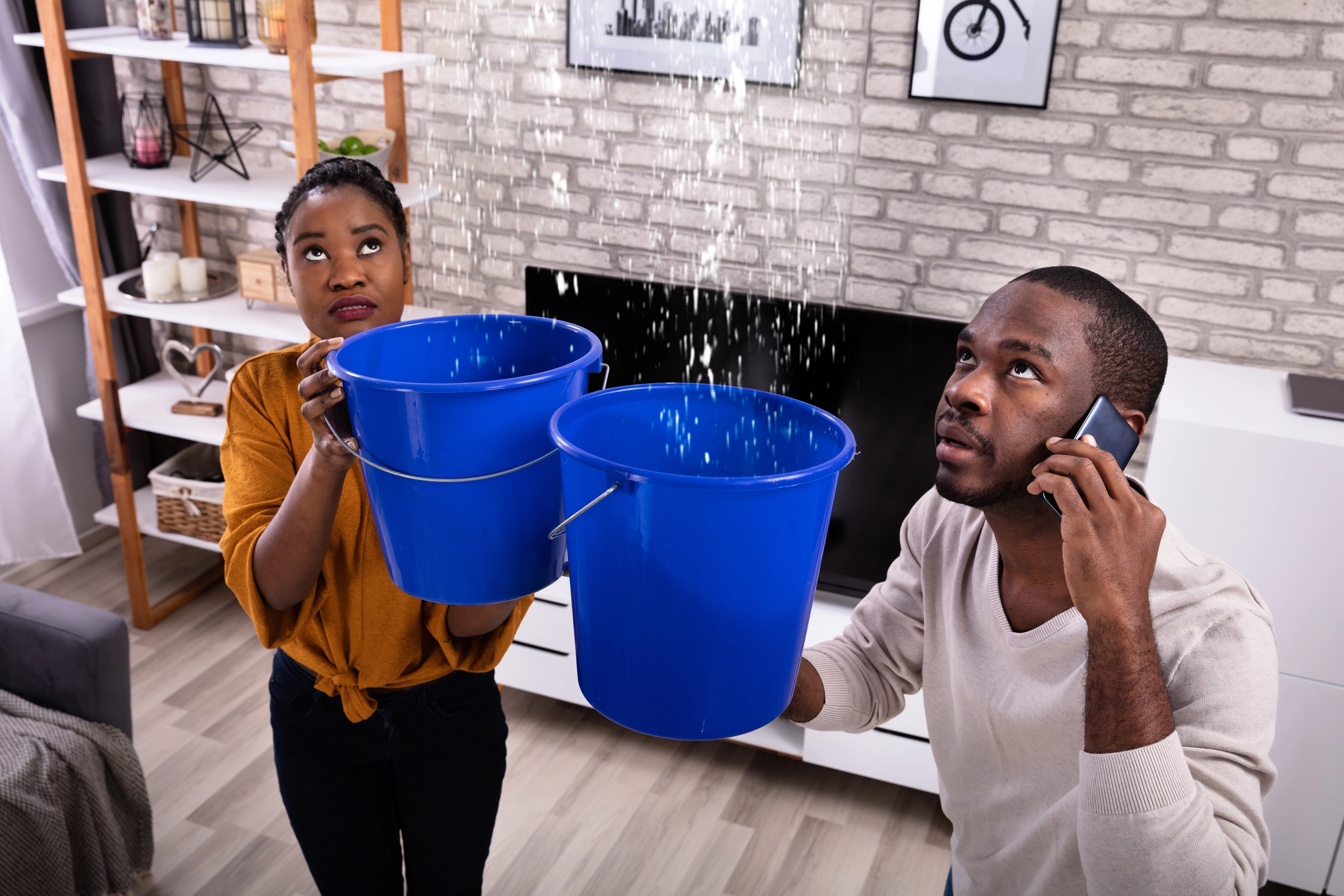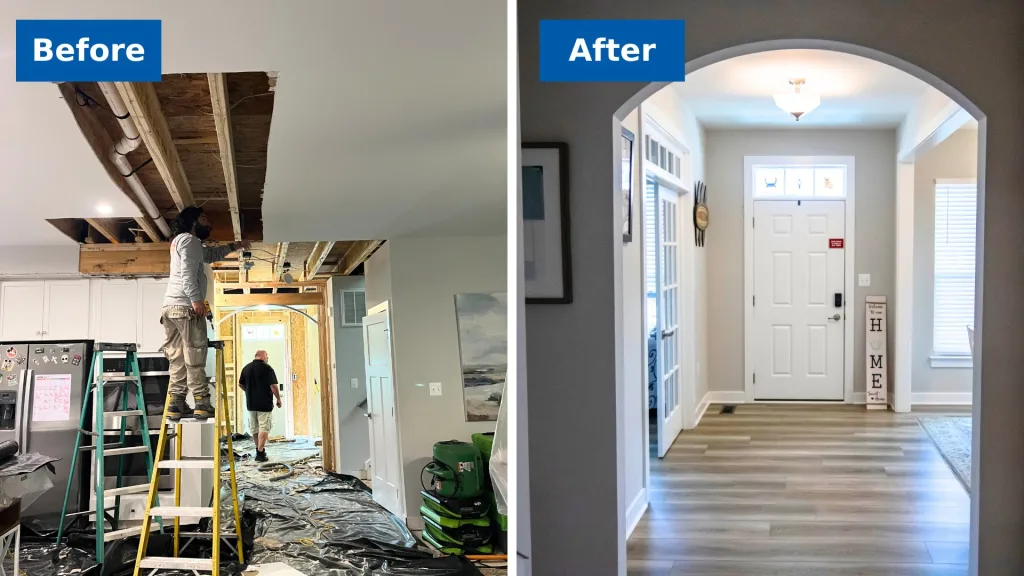DIY vs. Professional: When to Call Experts for Water Damage Cleanup
Wiki Article
The Complete Overview to Navigating the Obstacles of Water Damages Reconstruction
Water damages can strike suddenly, leaving you with a daunting mess to tidy up. Comprehending the reasons and examining the level of the damages is crucial. Your prompt actions can make a considerable difference in the result. What steps should you take initially, and how can you ensure you're shielded moving onward? The responses hinge on a complete approach to restoration that every homeowner need to understand.
Understanding the Reasons For Water Damage
Water damage can strike all of a sudden, usually leaving you scrambling to deal with the consequences. Comprehending the sources of water damage is important for prevention. Flood Damage Restoration. Typical offenders consist of dripping roofs, ruptured pipelines, or malfunctioning home appliances. You could also come across problems with your plumbing systems, like clogged up drains pipes or sewage back-ups, which can cause substantial water invasion. Weather-related incidents, such as hefty rains or flooding, can also ruin your residential property. Furthermore, the age of your home contributes; older frameworks frequently have wearing away materials that are much more prone to leaks and damage. Even small problems, like condensation from cooling and heating systems, can accumulate and cause problems over time. By determining these possible resources of water damages, you can take positive steps to guard your home and reduce future threats. Remaining informed will equip you to acknowledge early signs and act swiftly when problems developAnalyzing the Extent of the Damage
When you've identified a possible water damages problem, assessing the degree of the damage is important for figuring out the ideal reaction. Begin by inspecting the influenced locations completely. Look for visible indicators like water discolorations, deformed floorings, or peeling paint. Don't forget to inspect covert areas, such as behind walls or under carpetings, where dampness might linger.Next, identified the type of water included-- clean, grey, or black-- considering that this affects the extent of the damage and essential removal steps. Use a dampness meter to gauge moisture levels in walls and floorings, assisting you determine sticking around moisture that might bring about mold growth.Document every little thing with photos and notes, as this details can be vital for insurance claims. By precisely examining the damage, you'll be better equipped to pick the right remediation method and protect against further issues down the line.Immediate Tips to Take After Water Damages
After experiencing water damages, the first point you require to do is evaluate the circumstance very carefully. Prioritizing your safety and security is crucial, so see to it the area is safe before taking any kind of additional actions. Don't fail to remember to document whatever thoroughly, as this will be necessary for insurance coverage cases and repair initiatives.Assess the Damages
Reviewing the damages promptly is necessary for minimizing the influence of water intrusion. Beginning by inspecting the impacted areas to establish the degree of the water damages - Water Damage Repair. Search for noticeable indications like soaked carpetings, warped floorings, and tarnished walls. Check for concealed water, also, particularly in crawl spaces and behind appliances. Use a moisture meter if you have one, as it can assist identify areas that need interest. Paper whatever with pictures and notes; this will certainly serve for insurance cases. Remember to assess your items as well-- furniture and individual products may need expert cleaning or disposal. By recognizing the extent of the damages, you can make enlightened choices about the following action in the reconstruction procedurePrioritize Safety And Security First
Recognizing the level of water damage is just the beginning; your safety precedes. Before you enter a water-damaged location, make certain to switch off the electrical energy and gas supply to avoid any type of hazards. Wear safety gear, consisting of handwear covers and boots, to shield yourself from contaminants. Beware of structural instability-- ceilings, floors, or walls might have deteriorated. Avoid call and call professionals for help if the water is coming from a sewer source. Maintain children and pets away from the afflicted area. If you smell gas or see electric triggers, leave promptly. Remember, prioritizing your safety and security warranties you can successfully deal with the damage without danger to your health. Constantly err on the side of caution.Document Everything Completely
As you start attending to water damages, recording whatever completely is crucial for both insurance claims and restoration efforts. Begin by taking clear pictures of the influenced locations, capturing the level of the damages. See to it to keep in mind the date and time of the case. Produce a listing of harmed items, consisting of furniture, home appliances, and personal belongings, together with their estimated worths. Record any actions you take, like getting in touch with professionals or moving items to prevent more damage. Maintain all invoices and receipts related to the repair process. When submitting a claim and help the repair team understand the situation much better, this paperwork will certainly reinforce your situation (Flood Damage Restoration). Remember, thorough documents can make a significant difference in your recovery journey
Avoiding and alleviating additional issues Mold and mildew Growth
When water damages takes place, acting rapidly can significantly minimize the threat of additional concerns, specifically mold growth. First, remove any kind of standing water utilizing pumps or damp vacuum cleaners. Next off, dry the impacted areas completely. Open home windows, utilize followers, and consider dehumidifiers to accelerate the drying procedure. Purpose for a moisture level below 60% to hinder mold spores from settling.Inspect all surfaces and products affected by water; dispose of anything that can't be adequately dried out, like soaked carpets or drywall. Clean and sanitize staying surfaces with a blend of water and detergent, or a specialized mold-preventive solution.Keep an eye on the location over the following few weeks. If you notice any type of moldy smells or staining, address it promptly. Keep in mind, timely activity not only prevents mold and mildew development however additionally safeguards your building and wellness.Dealing With Water Damages Remediation Experts
After taking instant steps to minimize water damages and avoid mold and mildew development, it's time to contemplate specialist assistance. Water damages repair professionals have the expertise and equipment required to deal with extensive damage properly. When you connect, be all set to describe the situation thoroughly. This aids them assess the extent of the damages and prepare accordingly.Once they get here, expect a detailed evaluation and an in-depth plan for repair. They'll utilize customized tools to remove water, dry out impacted areas, and sanitize your space. Do not hesitate to ask concerns throughout the procedure; recognizing their approaches can alleviate your concerns.You must also talk about timelines and what to anticipate at each stage of the reconstruction. Working together openly with these experts guarantees you stay educated and included, helping you regain your room a lot more efficiently. Trust their knowledge, and you'll see your home return to its pre-damage problem.Navigating Insurance Coverage Claims for Water Damage
Steering insurance coverage claims for water damages can really feel frustrating, especially if you're unfamiliar with the procedure. Review your insurance policy to understand what's covered. Try to find specifics on water damage, as not all plans treat it the same. Record the damages extensively-- take images and make notes concerning what took place and when.Next, contact your insurance coverage supplier quickly. Record the damages and provide them with your documentation. They'll designate an insurer to analyze the circumstance. Be prepared to respond to concerns and provide additional details as needed.Stay arranged throughout the process. Keep a document of all interactions, consisting of days, names, and information of discussions. If your claim is denied or you feel it's not enough, don't think twice to appeal. Know that perseverance can settle, so supporter on your own to ensure you get the insurance coverage you're entitled to.Tips for Future Water Damages Avoidance
To keep your home risk-free from water damage, normal upkeep checks are necessary. Don't ignore the value of mounting water detection systems, as they can alert you to leaks before they come to be significant problems. By staying positive, you can conserve yourself time, cash, and anxiety down the road.Routine Upkeep Checks
While it may appear tedious, conducting normal maintenance checks can considerably reduce the risk of future water damage in your house. Begin by examining your roofing system for missing out on tiles or leakages; also tiny problems can escalate promptly. Examine rain gutters and downspouts to guarantee they're clear and guiding water far from your structure. Try to find signs of moisture in basements or crawl spaces, and deal with any kind of leakages from pipes or home appliances quickly. Bear in mind to test your sump pump frequently to verify it's operating appropriately. Do not ignore your cleaning machine tubes; change them every few years to stop ruptured catastrophes. By remaining positive with these checks, you'll save on your own time, cash, and tension over time.Set Up Water Detection Solutions

Regularly Asked Concerns
How much time Does the Water Damage Reconstruction Process Usually Take?
The water damages remediation procedure typically takes anywhere from a few days to numerous weeks, relying on the extent of the damages. You'll desire to act promptly to reduce more concerns and speed up the process.Can I Remain In My Home Throughout the Remediation Process?
You can stay in your home throughout the reconstruction process, yet it depends on the level of the damage. If it's extreme, it's safer to momentarily move till the job's finished and your home's safe.What Individual Things Can Be Salvaged After Water Damages?
After water damage, you can frequently recover things like apparel, publications, and electronics, provided they're not saturated or moldy. Constantly assess their condition swiftly and speak with specialists for guidance on remediation and safety and security.Exist Any DIY Techniques for Bring Back Water-Damaged Products?
Yes, you can utilize DIY techniques to recover water-damaged things. For furniture, air-dry and apply a timber conditioner. For fabrics, wash them extensively and air-dry. Constantly examine for mold and mildew before attempting any restoration.Exactly How Can I Determine Hidden Water Damages in My Home?
To determine concealed water damages, look for water spots on walls and ceilings, pay attention for trickling noises, really feel for moisture in products, and analyze areas near plumbing for signs of mold or mold growth. As soon as you've determined a possible water damages issue, evaluating the extent of the damages is essential for establishing the ideal action. As you start dealing with water damages, recording everything completely is necessary for both insurance coverage cases and restoration efforts. Water damage repair experts have the knowledge and devices needed to handle extensive damage efficiently. Installing water discovery systems can be a game-changer for stopping future water damage in your home. The water damages repair procedure typically takes anywhere from a few days to a number of weeks, depending on the extent of the damages.Report this wiki page